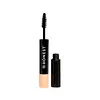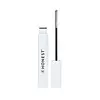Honest Beauty Extreme Volume Mascara + Bold Lash Primer Versus Honest Beauty Honestly Healthy Serum-Infused Lash Tint
What's inside
What's inside
 Key Ingredients
Key Ingredients

 Benefits
Benefits

 Concerns
Concerns

 Ingredients Side-by-side
Ingredients Side-by-side

Water
Skin ConditioningPolyhydroxystearic Acid
EmulsifyingCopernicia Cerifera Wax
Dioctyldodecyl Dimer Dilinoleate
EmollientGlyceryl Stearate Se
EmulsifyingPolyglyceryl-6 Distearate
EmulsifyingPolyglyceryl-10 Stearate
Skin ConditioningStearic Acid
CleansingPropanediol
SolventHydrolyzed Corn Starch
HumectantCellulose
AbsorbentSilica
AbrasiveRicinus Communis Seed Oil
MaskingGlycerin
HumectantMicrocrystalline Cellulose
AbsorbentAloe Barbadensis Leaf Juice Powder
Skin ConditioningAlgin
MaskingXanthan Gum
EmulsifyingPanthenol
Skin ConditioningCitric Acid
BufferingTrisodium Ethylenediamine Disuccinate
Hydroxyacetophenone
Antioxidant1,2-Hexanediol
Skin ConditioningCaprylyl Glycol
EmollientCI 77007
Cosmetic ColorantPullulan
Sorbitol
HumectantAcacia Senegal Gum
MaskingTrehalose
HumectantCI 77499
Cosmetic ColorantWater, Polyhydroxystearic Acid, Copernicia Cerifera Wax, Dioctyldodecyl Dimer Dilinoleate, Glyceryl Stearate Se, Polyglyceryl-6 Distearate, Polyglyceryl-10 Stearate, Stearic Acid, Propanediol, Hydrolyzed Corn Starch, Cellulose, Silica, Ricinus Communis Seed Oil, Glycerin, Microcrystalline Cellulose, Aloe Barbadensis Leaf Juice Powder, Algin, Xanthan Gum, Panthenol, Citric Acid, Trisodium Ethylenediamine Disuccinate, Hydroxyacetophenone, 1,2-Hexanediol, Caprylyl Glycol, CI 77007, Pullulan, Sorbitol, Acacia Senegal Gum, Trehalose, CI 77499
Water
Skin ConditioningBeeswax
Emulsion StabilisingGlycerin
HumectantJojoba Esters
EmollientCopernicia Cerifera Wax
Glyceryl Stearate
EmollientCetyl Palmitate
EmollientSorbitan Olivate
EmulsifyingSorbitan Palmitate
EmulsifyingCastor Isostearate Beeswax Succinate
Skin ConditioningCetearyl Alcohol
EmollientTrifolium Pratense/Vigna Radiata) Sprout Extract
AntioxidantHydrolyzed Vegetable Protein
Skin ConditioningRicinus Communis Seed Oil
MaskingCellulose Gum
Emulsion StabilisingCaprylyl Glycol
EmollientPullulan
Hydroxyacetophenone
AntioxidantXanthan Gum
Emulsifying1,2-Hexanediol
Skin ConditioningSodium Phytate
Trisodium Ethylenediamine Disuccinate
Tocopherol
AntioxidantNiacinamide
SmoothingPanthenol
Skin ConditioningSodium Carbonate
BufferingMethyl Dihydroabietate
Sodium Hydroxide
BufferingWater, Beeswax, Glycerin, Jojoba Esters, Copernicia Cerifera Wax, Glyceryl Stearate, Cetyl Palmitate, Sorbitan Olivate, Sorbitan Palmitate, Castor Isostearate Beeswax Succinate, Cetearyl Alcohol, Trifolium Pratense/Vigna Radiata) Sprout Extract, Hydrolyzed Vegetable Protein, Ricinus Communis Seed Oil, Cellulose Gum, Caprylyl Glycol, Pullulan, Hydroxyacetophenone, Xanthan Gum, 1,2-Hexanediol, Sodium Phytate, Trisodium Ethylenediamine Disuccinate, Tocopherol, Niacinamide, Panthenol, Sodium Carbonate, Methyl Dihydroabietate, Sodium Hydroxide
Ingredients Explained
These ingredients are found in both products.
Ingredients higher up in an ingredient list are typically present in a larger amount.
1,2-Hexanediol is a synthetic liquid and another multi-functional powerhouse.
It is a:
- Humectant, drawing moisture into the skin
- Emollient, helping to soften skin
- Solvent, dispersing and stabilizing formulas
- Preservative booster, enhancing the antimicrobial activity of other preservatives
Caprylyl Glycol is a humectant and emollient, meaning it attracts and preserves moisture.
It is a common ingredient in many products, especially those designed to hydrate skin. The primary benefits are retaining moisture, skin softening, and promoting a healthy skin barrier.
Though Caprylyl Glycol is an alcohol derived from fatty acids, it is not the kind that can dry out skin.
This ingredient is also used as a preservative to extend the life of products. It has slight antimicrobial properties.
Learn more about Caprylyl GlycolCopernicia Cerifera Wax comes from a palm tree native to Brazil; another name for this ingredient is Carnauba Wax.
This ingredient is used to thicken texture and also leaves behind a film when applied.
Fun fact: This wax has the highest melting point of all natural waxes and low solubility.
Learn more about Copernicia Cerifera WaxGlycerin is already naturally found in your skin. It helps moisturize and protect your skin.
A study from 2016 found glycerin to be more effective as a humectant than AHAs and hyaluronic acid.
As a humectant, it helps the skin stay hydrated by pulling moisture to your skin. The low molecular weight of glycerin allows it to pull moisture into the deeper layers of your skin.
Hydrated skin improves your skin barrier; Your skin barrier helps protect against irritants and bacteria.
Glycerin has also been found to have antimicrobial and antiviral properties. Due to these properties, glycerin is often used in wound and burn treatments.
In cosmetics, glycerin is usually derived from plants such as soybean or palm. However, it can also be sourced from animals, such as tallow or animal fat.
This ingredient is organic, colorless, odorless, and non-toxic.
Glycerin is the name for this ingredient in American English. British English uses Glycerol/Glycerine.
Learn more about GlycerinHydroxyacetophenone is antioxidant with skin conditioning and soothing properties. It also boosts the efficiency of preservatives.
This ingredient is not irritating or sensitizing.
Panthenol is a common ingredient that helps hydrate and soothe the skin. It is found naturally in our skin and hair.
There are two forms of panthenol: D and L.
D-panthenol is also known as dexpanthenol. Most cosmetics use dexpanthenol or a mixture of D and L-panthenol.
Panthenol is famous due to its ability to go deeper into the skin's layers. Using this ingredient has numerous pros (and no cons):
Like hyaluronic acid, panthenol is a humectant. Humectants are able to bind and hold large amounts of water to keep skin hydrated.
This ingredient works well for wound healing. It works by increasing tissue in the wound and helps close open wounds.
Once oxidized, panthenol converts to pantothenic acid. Panthothenic acid is found in all living cells.
This ingredient is also referred to as pro-vitamin B5.
Learn more about PanthenolPullulan is a low viscosity polysaccharide (a long chain carbohydrate) with binding and film forming properties when dissolved in water. It is used to create a "silicone-like" or silky feel in cosmetics without adding viscosity.
According to a manufacturer, this ingredient's ability to easily dissolves makes it a great carrier for active ingredients.
Due to it being edible and tasteless, you'll likely find this ingredient in breath freshener strips. This ingredient is produced from the starch of the fungus, Aureobasidium pullulans.
Pullulan is stable over a broad-range of pH.
Learn more about PullulanRicinus Communis Seed Oil is the INCI name for castor oil.
Castor Oil helps moisturize the skin. It is rich in a fatty acid called ricinoleic acid. This fatty acid helps prevent moisture loss on the skin. This helps keep your skin soft and hydrated. Ricinoleic acid also has anti-inflammatory and pain reducing properties.
Besides hydrating the skin, castor oil is also used to hydrate hair. By keeping the hair shaft moisturized, breakage is decreased. More studies are needed to show castor oil's effective on stimulating hair growth.
Castor oil is created by cold-pressing castor seeds and then purifying the oil with heat. It was used in Ancient Egypt as fuel in lamps and to help treat eye irritation.
The term 'fragrance' is not regulated in many countries. In many cases, it is up to the brand to define this term. For instance, many brands choose to label themselves as "fragrance-free" because they are not using synthetic fragrances. However, their products may still contain ingredients such as essential oils that are considered a fragrance.
Learn more about Ricinus Communis Seed OilTrisodium Ethylenediamine Disuccinate is used to help stabilize a product.
It is a chelating agent, meaning it helps prevent metal ions from binding to other ingredients. This prevents unwanted reactions in products. Metal ions can come into a product via the water ingredient. They are found in trace amounts and are not known to be harmful.
Water. It's the most common cosmetic ingredient of all. You'll usually see it at the top of ingredient lists, meaning that it makes up the largest part of the product.
So why is it so popular? Water most often acts as a solvent - this means that it helps dissolve other ingredients into the formulation.
You'll also recognize water as that liquid we all need to stay alive. If you see this, drink a glass of water. Stay hydrated!
Learn more about WaterXanthan gum is used as a stabilizer and thickener within cosmetic products. It helps give products a sticky, thick feeling - preventing them from being too runny.
On the technical side of things, xanthan gum is a polysaccharide - a combination consisting of multiple sugar molecules bonded together.
Xanthan gum is a pretty common and great ingredient. It is a natural, non-toxic, non-irritating ingredient that is also commonly used in food products.
Learn more about Xanthan Gum